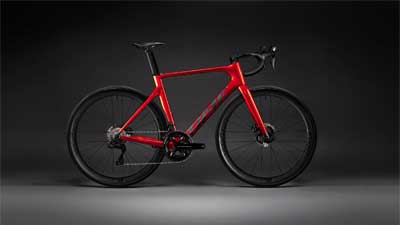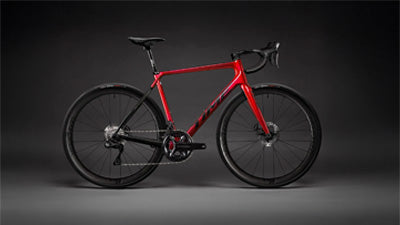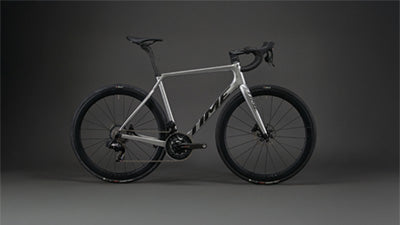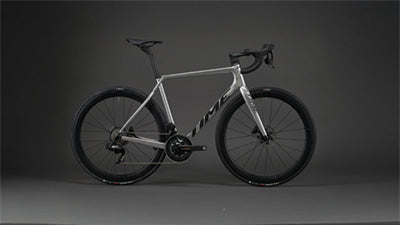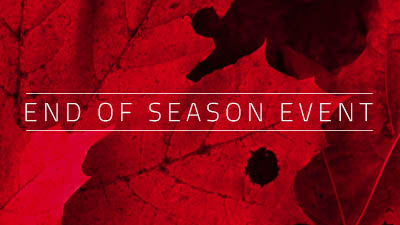We've delved into the TIME archives and uncovered this gem from 2015 when James Witts from the UK's Cyclist Magazine visited our factory.

One French bicycle manufacturer refuses to do things the same way as all the others. Cyclist weaves its way to Lyon to discover the secrets of Time.
That? Oh, it’s crocodile skin. It came from Australia. Not the whole croc, of course – just the leather from the belly.’ So says Florian Bebert, Time’s product manager (or, in French, the rather culinary sounding chef de produits). We’re not talking about the material for the latest Gucci shoes or Bottega handbag, but the bar tape for a project Time is working on with a luxury brand. Whatever your ethical stance, you can’t fault the attention to detail.
It’s an approach Time has used since Roland Cattin founded the company in 1987. Cattin, a charismatic and elegant man, wanted the company to do things with a certain savoir faire reflecting his own attitude. His legacy looms large as Cyclist arrives at the factory in Vaulx-Milieu on the outskirts of Lyon. Just three weeks earlier, Cattin died of a heart attack following a bike ride with his wife. He was 65. ‘When we were told, everyone was in tears,’ says Bebert, who’s my guide for the day. ‘He was really human. If anyone had a personal or professional problem, he always had an ear. But he knew the technical side of things, too. Cycling coursed through his veins.’ While the majority of the cycling industry headed to the Far East in search of cheap labour, Cattin stood firm, and remained committed to producing his carbon frames in France.

Time originally carved its reputation in the world of pedals. Soon after Look invented the first clipless model in 1984, Time followed suit, designing the first clipless with float. In this brave new world devoid of toe straps, it soon began racking up victories in the pro peloton: Pedro Delgado at the 1988 Vuelta, Greg LeMond at the 1989 Tour de France, Miguel Indurain, Marco Pantani, Jan Ullrich, Laurent Fignon… the list goes on. That platform for success was manufactured in Nevers, central France. So why is it, on this chilly winter’s morning, we find ourselves in Lyon?
‘Because this area’s long been associated with weaving,’ explains Bebert, ‘and that’s the secret to our frames.’ And with that, Time weaves its tale…
The bike is the star
Enter the modern offices of Time and you’re soon reflecting on the past. Ascend to the boardroom and you pass Tom Boonen’s 2005 Roubaix-winning Time bike.
Continue up the stairs and there’s Paolo Bettini’s, the one he won the World Championships with in 2006. Cyclists love a sprinkling of nostalgia, but we’re here to see how Time produces its most modern frames. The usual method at most companies is to place sheets of resin impregnated carbon fibre (aka pre-preg) into a mould, but as Bebert says, ‘Here we do things differently. We weave.’
On the factory floor, Bebert opens the weighty doors that help to block out the noise of 12 giant looms that seem to be dancing in unison. ‘This is how we make our carbon frames, and it is why we moved to Lyon.’

Each loom contains varying numbers of bobbins wrapped with 1km of carbon fibre, often accompanied by bobbins containing threads of Vectran or Kevlar. The Vectran is incorporated into frame parts that require greater flexibility, while the Kevlar adds protection on areas such as steerer tubes.
The fibres from each bobbin combine at a rotating central point and are then fed through a small hole at the top of the machine, which excretes a carbon sock that’s subsequently compressed through a mangle.
‘We use three different types of fibres predominantly sourced from Toray in Japan,’ says Bebert, Toray being one of the world’s largest producers of carbon fibre. ‘We have 3K, 6K and 12K [tow – the different weights of carbon fibre filaments]. We also vary the angle of the weave between 15° and 65° or unidirectional.’ The differing angles help to define the torsional or longitudinal stiffness of the tubes.
‘Some people think carbon is just carbon,’ Bebert says. ‘It’s not. There’s a huge amount of difference between what we do and what our competitors do.’ Once the carbon is woven, it’s taken to the cutting room where a band of women work dextrously with the carbon socks, scissors and cire perdue. ‘Or lost wax, I think you call it,’ says Bebert. The carbon fibre is laid around the wax to form the tube shapes, with the wax being melted, or ‘lost’, when heated to a sufficient temperature later in the process. Time creates moulds for forks, top tubes and wishbones using this method, with each handled by workers with specialist knowledge of that particular part. They add numerous layers of carbon fibre depending on the part – high-stress points such as bottom brackets, for instance, have the most layers – all tightened in place with carbon strands.
The sections of wax are then linked to form the front triangle. Time offers seven sizes, from XXXS to XL, so that’s a lot of wax. The staff make light work of an intricate and time-consuming process, and I begin to see why a Time frameset can cost up to £3,700.
Before it’s all sent for heat and compression, ‘we add a layer of pre-preg carbon’, says Bebert. ‘It’s for aesthetic reasons.’ I look at Bebert, and he can see from my expression the question that is forming in my mind. Why, when you’ve gone to the effort of producing a frame forged in a unique and beautiful way, would you cover it up with a layer of material that you’ve already pronounced as being an inferior product?
‘Yes, it does seem a shame to cover it up, and I’m keen to create a raw model,’ Bebert says almost apologetically. I can only guess that Time has decided that customers prefer their bikes to look a particular way, but I hope that Bebert gets his wish, and the company produces a raw model, because it would allow people to see the beauty of its production process for themselves.

The smell of speed
Moving from the cutting area to the moulding area, the first thing that hits me is the smell. The aroma of glue fills the air, and I wonder about its effects on the employees who have to cope with this for 35 hours each week. It’s all in the name of innovation, though, which I’m sure will appease the toxicologists.
It’s also warm. Both sensory attacks emanate from a two-part steel mould that now encases the carbonwrapped triangle of cire perdue. The mould is closed, and tilted to an angle by a mechanical arm, which Bebert tells me means less pressure is needed, making it less demanding for the machine. Resin is then injected into the mould via tubes through a single entry point, and the temperature is gradually increased to 110°C, solidifying the carbon fibres and resin.
Then it’s over to another oven heated to a slightly higher temperature so that the wax melts, dripping out of the machine into vats to be recycled. It’s a clever process and one over which Time has full control, as it also creates its wax moulds in-house.
‘It leaves a perfect frame and gives you 0.1mm precision,’ says Bebert. ‘You can’t get that with pre-preg because you often use an air bladder to create the shape and simply inflate. That’s not as consistent as this method.’
The frame then goes through a total of 12 different processes over five days, including sanding, sandblasting, drilling, cutting and general tidying, before it’s ready for the dramatic finale: the paintjob. Time is synonymous with black, red and white, although its top-end Skylon aero road bike comes with an option of a slick black and yellow colourway. However, leaning against the wall is a stunning green number. It’s not for sale but, as is typical with Time, there’s a story to tell.
‘Green isn’t our colour, but in 2013 Saint-Étienne reached the Coupe de la Ligue [France’s league cup] final against Rennes. Their president is a huge cycling fan and said to the staff, if they reached the final, they’d cycle to the Stade de France in Paris. So he ordered 42 bikes in the club’s colours and they cycled 550km to the final. Thankfully, Saint-Étienne won 1-0.’ Presumably the winner’s cheque covered the cost of the bikes.
King of carbon
We leave the factory floor and head back to the boardroom. Sitting in the corner is a stocky but trim gentleman, his healthy tan adding sophistication to his greying crown. ‘That’s Jean-Marc Gueugneaud,’ says Bebert with barely disguised excitement. ‘He’s an absolute god, especially in Japan where they totally understand what we do.’
Gueugneaud greets us warmly, and it’s not long before he’s relating the stories he has plainly told many times before. ‘I made the first carbon frame back in 1982,’ he says in a soft lilt that floats with the ease of one of Time’s pedals. ‘I was working at Mercier, just south west of here. We produced metallic frames and nearly won the Tour, twice finishing second with Raymond Poulidor and Joop Zoetemelk. While there, a colleague asked for a solution to his prototype and I offered my expertise. I made the first carbon bike on a jig and joined it with lugs.’
Gueugneaud was surprised by the results and continued to develop the technology. At the same time, the French aerospace company TVT (Technique du Verre Tissé) was looking to make its presence felt in the world of cycling, and recruited Gueugneaud to its ranks, where he helped to make its first carbon frame and fork combination. It was then, at a trade show in Paris, that his good friend Alain Decroix asked him if he’d provide a bike for Bernard Hinault, for whom Decroix worked as a mechanic.

‘Of course, I said yes. Hinault had a good opinion of the bike and in February 1986 rode it on the first stage of the Tour de Mediterranean. I didn’t even know he was going to, and it was always difficult to ask Bernard a question! He then had a few bad comments, but I was confident in the frame and it turned out the problems were with the fork.’
That night, the carbon fork was replaced by a steel one. Hinault was delighted with the outcome and, although the race went to his La Vie Claire team-mate Jean-Francois Bernard, the Badger had seen enough to convince him his team should ride the bikes at that year’s Tour de France.
‘That was a confusing one. La Vie Claire was sponsored by Look. Both were owned by [French businessman] Bernard Tapie. Hinault was a legend and his word goes, so come the Tour, the team are riding TVT frames with Look and Reynolds branding.’ In that iconic image of LeMond and Hinault, hand in hand at the finish line of Alpe d’Huez, Hinault is actually aboard Gueugneaud’s handiwork.
Tapie, clearly impressed with the potential performance benefits of carbon, cut a deal with TVT. It would make the carbon parts, while Look would glue them together and have its branding plastered all over the frames.
The uneasy truce didn’t last, and TVT terminated the deal at the end of 1987, reverting to supplying bikes for particular riders. ‘We gave Pedro Delgado a bike for the 1988 Tour and he got into trouble with Pinarello and Columbus [steel tubing],’ says Gueugneaud. ‘But he was in yellow and told everyone he’d win the race on this bike. Stage after stage, more and more Columbus stickers plastered the frame. It must have weighed him down! Delgado won and it was quite funny. At the start of the season, TVT only sold blue bikes. Pedro won on a red TVT [Pinarello], so by the end of that race, everyone unknowingly wanted a red TVT!’
Take your pick
Despite being approached by Look, Gueugneaud was tempted by an offer from Cattin, who had founded Time three years earlier. The pedal manufacturer wanted to move into carbon frames. ‘I agreed to join, but told Roland he must manufacture the frames in the Lyon area because of its weaving heritage.’
Gueugneaud joined forces with Decroix and the two of them set about redefining the industry from a small workshop in Lyon. In 1993, Time launched its first carbon frame, and the rest is history. ‘It’s been an amazing journey ever since. We’ve had many highs and many lows,’ he says.
Cyclist presses him to name the finest rider to have graced one of his frames. ‘Well, it’s hard to look beyond Hinault. He was the first – you always remember your first girlfriend. But I really liked Tom Boonen. He was the only rider we made a bespoke model for [the Time VXS for the 2006 Spring Classics]. When we lost sponsorship of Quick-Step to Specialized I was gutted. I think Tom was, too. He told a Belgian newspaper that where once he drove a Ferrari, he now drove a Renault. That made me smile.’
That raises the matter of WorldTour teams. Time has supplied bikes for Saur-Sojasun, Quick-Step-Innergetic, Cofidis and Bouygues Telecom, back in the days when providing a fleet of bicycles was enough to secure sponsorship. Now it’s bikes plus cash. ‘It’s very expensive,’ says Bebert, before revealing the company nearly signed with a WorldTour team before Cattin’s sudden passing.
‘It was too soon after Roland’s death, but maybe in the future. Roland’s daughter has confirmed she’ll become heavily involved and continue his great work.’ Clearly carbon-weaved bikes, like savoir faire, is in the DNA.


